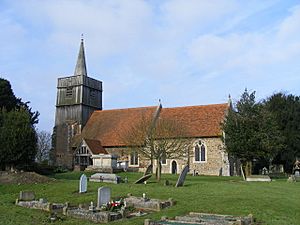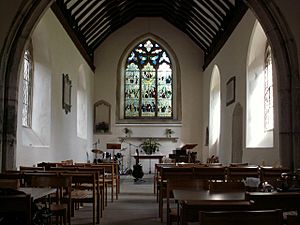St Andrew's Church, Marks Tey facts for kids
Quick facts for kids St Andrew's Church |
|
|---|---|

Exterior
|
|
| 51°52′51″N 0°46′32″E / 51.88075°N 0.77546°E | |
| Country | England |
| Denomination | Church of England |
| Previous denomination | Roman Catholic |
| Churchmanship | Charismatic Evangelical |
| History | |
| Status | Active |
| Architecture | |
| Heritage designation | Grade I listed |
| Designated | 7 April 1965 |
| Administration | |
| Parish | Marks Tey |
| Diocese | Chelmsford |
| Province | Canterbury |
St Andrew's Church is a historic building in the village of Marks Tey in Essex, England. It is a Church of England parish church, meaning it serves the local community. This church is very special because it was given a "Grade I listed" status in 1965. This means it is considered a building of exceptional historical or architectural importance.
The main part of the church, called the nave, was built around the year 1100. Imagine, that's over 900 years ago! The walls were made from different kinds of stone and even some old Roman bricks. These bricks might have come from a Roman villa that was once in the area.
The chancel, which is the part of the church where the altar is, was rebuilt much later, around 1330. Inside the chancel, you can find some interesting old features. There's a sedilla, which is a set of seats for the clergy, and a piscina, a basin used for washing sacred vessels. There was also a doorway that led to a rood screen, a special screen that used to separate the chancel from the nave.
Church Tower and Other Features
The church's tower and its small spire were added in the 16th century. The bottom part of the tower is made of brick and stone, while the top two-thirds are made of wood. There's also a south porch that was built in the 16th century, and a beautiful cover for the font (where baptisms happen) from the early 17th century. The whole church building was carefully repaired and updated in the 19th century.
The Millennium Window
A special feature in the church is the Millennium window. It was created by an artist named Susan McCarthy. This window tells stories and shows different ideas that are important to the history of Marks Tey village. It also reminds people that the main message of the Gospel has stayed the same over time.
External links
- St Andrew's Church website


